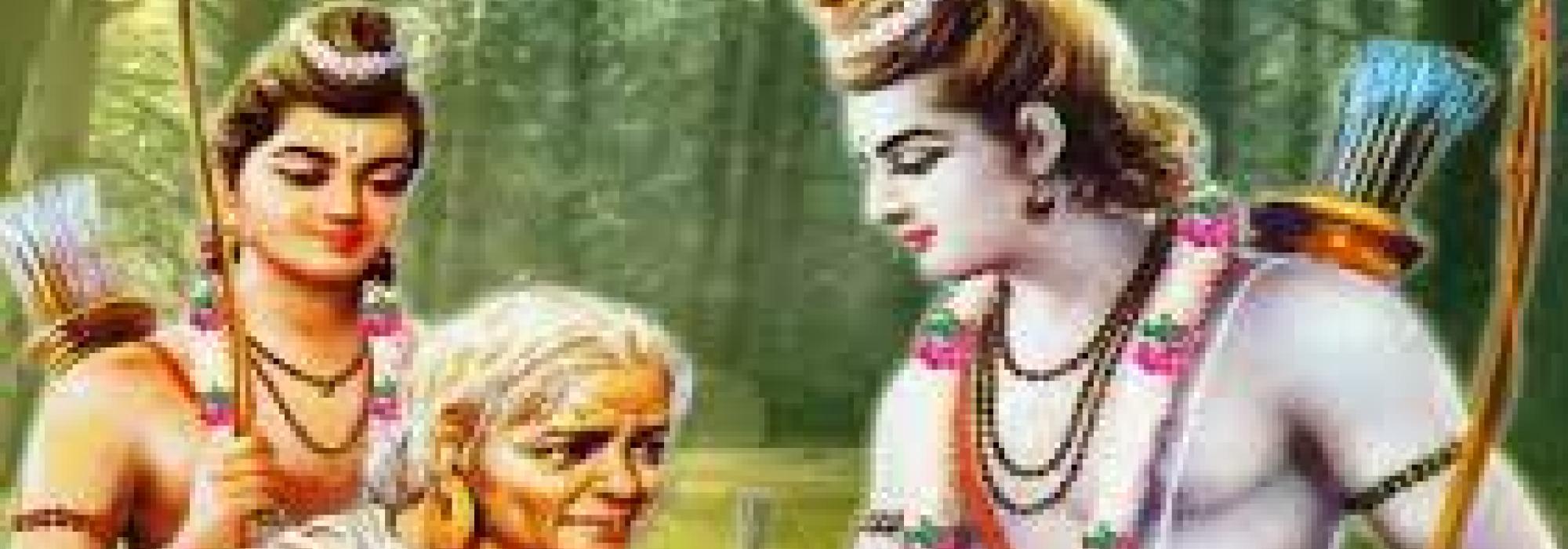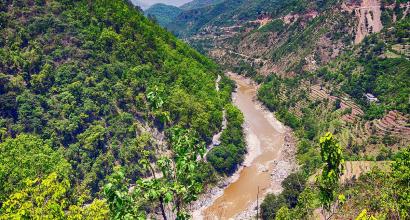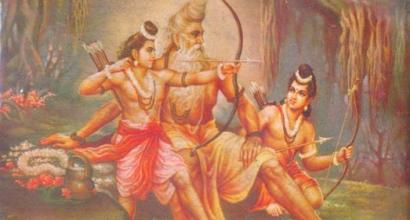Though Rāghava was the elder of the two, he immediately accepted the advice of Lakṣmaṇa, recognising the essential truth the latter had spoken. Accordingly, the brothers went ahead searching for Sītā in all possible places. They spotted the illustrious Jaṭāyu, as huge as a mountain peak, drenched in blood. Immediately, Rāma told Lakṣmaṇa, “Sītā has been undoubtedly devoured by this creature. This is certainly a rākṣasa, who roams around in the forest in the form of a vulture. Look at him! He lies there comfortably, having killed my beloved. I shall kill him right away with my arrows.” Rāma got ready an arrow on his bow and rushed towards the vulture, with a gait that seemed to shake the earth.
The bird, however, addressed Rāma in an extremely feeble voice, vomiting frothy blood as he spoke. “O Rāghava, The gentle lady whom you seek—like seeking a rare life-giving herb in the deep forest—was snatched away by Rāvaṇa along with my life-breaths. I saw her being carried off by Rāvaṇa when you and Lakṣmaṇa were away. I rushed to Sītā’s aid, fought with him here, and hurled him down from his chariot, which I also destroyed. This is his broken bow and this, his armour. As I grew exhausted in the battle, Rāvaṇa pulled out his sword and chopped my wings, and rose into the sky carrying Sītā with him. I have already been killed by the rākṣasa; you need not hit me again.”
Hearing this news about Sītā, something which he longed to hear, Rāma embraced the king of vultures and wept aloud along with Lakṣmaṇa. Rāma couldn’t control his sorrow when he saw the bird gasping for breath. He said to Saumitri, “My banishment from the kingdom, life in the forest, losing Sītā, and this bird slain – these kinds of misfortunes will even burn fire, the purifier of the world. If I were to try to cross the ocean, I am sure, with my ill fate, the ocean will dry up as well. There is no one else in the world who is as unlucky as me and no one is entangled in such a terrible net of calamity as I am. Because of my misfortune, this dear friend of my father, the aged vulture, lies on the ground mortally wounded.” Rāma and Lakṣmaṇa caressed Jaṭāyu again and again, showing him all the affection of a son for his father. He asked, “Where is Maithilī who is dear to me as my own life?” With these words, Rāghava threw himself on the ground crying. He continued, “O Jaṭāyu, if you can still speak, please tell me. Why did Rāvaṇa carry off Sītā? How have I ever wronged him? How did her beautiful, moon-like face appear when she was being abducted? And what words did she utter at that moment? What powers does the rākṣasa possess and what does he look like? O father, where is his dwelling?”
As Rāma continued to lament, Jaṭāyu told him in the feeblest voice, “Rāvaṇa carried her off in the sky; he used his magical powers to raise high winds and dense clouds. After he cut off my wings, the rākṣasa headed towards the South. I am finding it difficult to breathe and my eyes whirl, Rāghava. Rāvaṇa abducted Sītā at the time of the day – a muhūrta called vinda; anything lost at this hour will soon be recovered by its owner. But he was unaware of it; like a fish that bites the hook, he will soon perish. Do not be anguished about Janaka’s daughter. You will soon kill the rākṣasa and enjoy the company of Vaidehī.” The vulture replied to Rāma with a clear mind, but soon started vomiting blood mixed with flesh, for he was on the brink of death. He continued, “It was the son of Viśravas and brother of Vaiśravaṇa…” The bird breathed his last. Rāma, joined his hands and cried, “Speak! Speak!” The vulture’s head dropped to the ground, his legs stretched out rigidly, and his body shook violently.
Gazing at the dead vulture, Rāma said to Saumitri, “Having lived for long years happily in this place, though it was the abode of the rākṣasas, he now lies here, butchered. This lord of birds gave up his life for my sake. Saumitri! Everywhere, even among animals, one can find dharma, courage, and selflessness. These beings, which are considered by some as inferior creatures, come to the refuge of the weak and the helpless. Dear brother, the grief caused by the abduction of Sītā is not as hard to bear as the death of this vulture, who died for my cause. This lord of birds is as worthy of my reverence as the renowned king Daśaratha. Saumitri, fetch some firewood. I will kindle fire by rubbing them together and cremate him. O noble bird, you will attain the state attained by those who have performed yajñas, the āhitāgnis, and the valorous ones who don’t turn their back in battle. You will attain the state attained by those who have donated large pieces of land.”
Rāma cremated him sorrowfully, as if he were a kinsman. The brothers killed several large gazelles, chopped their flesh into pieces, and laid them on the green grass as an offering to the bird. Rāma quickly recited the mantras that brāhmaṇas utter for the departed. The brothers went down to the river Godāvarī and offered water (as tarpaṇa). The great vulture, which was struck down in battle after achieving a glorious feat, was purified according to the customs of the maharṣis and attained the highest state of puṇya.
~
Rāma and Lakṣmaṇa headed towards the West and the South, looking for Sītā in the forest. They traversed the untrodden path through the thick woods, tangled creepers, and dense overgrowth, which was frightful and difficult to penetrate. At a distance from the Janasthāna, they passed through the Krauñcāraṇya, which looked like a lump of clouds and was full of life. But then, the courageous Lakṣmaṇa, joined his hands in reverence and told his elder brother, “My arm throbs and fear has occupied my mind. I see inauspicious omens. This bird called vañculaka – the deceiver – cries and seems to foretell our defeat in battle!” As they walked ahead, they heard a deafening cry and then spotted a huge rākṣasa. As they went closer, they noticed that it was the rākṣasa Kabandha, who had no head or neck and his mouth was in his belly. His body was covered with needle-sharp hair; he was as tall as a lofty mountain and fearful like a black cloud. In his chest was a single, wide eye, which looked terrible and darted glances. He was licking his massive lips as he consumed at once many bears, lions, elephants, and deer. With his long hands, he was seizing all sorts of animals. He noticed the two brothers, seized them, and squeezed them with all his might. As the brothers were helplessly drawn in by the rākṣasa, he asked them, “Who are you both and why have you come here?”
Rāma’s mouth suddenly went dry out of fear, and he told Lakṣmaṇa, “We have suffered calamity after calamity, each worse than the previous. We have failed to recover my beloved and we are face to face with Death!” But looking at Saumitri’s steadfastness and valorous expression, Rāma wilfully steadied his heart. Lakṣmaṇa commanded, “Let us chop off his massive arms with our swords!” With a single stroke, Rāma skilfully cut off the rākṣasa’s right arm and Lakṣmaṇa the left. The rākṣasa collapsed, deluged with blood, and humbly asked the heroes, “Who are you two?”
Lakṣmaṇa replied, “He is Rāma, the heir of the Ikṣvākus and I am Lakṣmaṇa, his younger brother. A rākṣasa abducted his wife and we have come here searching for her. But who are you? Why do you live here with your headless trunk, with your legs broken and with a flaming mouth in your belly?”
Hearing Lakṣmaṇa’s words, Kabandha at once remembered what Indra had told him, was overjoyed and said, “Welcome, O best of men! By my good fortune, my arms have been severed by you. Listen, as I tell you exactly how I came to be so hideous in appearance as a result of my own evil conduct.
“Once upon a time, I was very handsome and was famous in the three worlds. I also took upon a scary colossal form from time to time to terrorise the worlds. I went from place to place and drove fear into the hearts of the ṛṣis. Once, I happened to enrage a mahaṛṣi named Sthūlaśiras and he cursed that I should remain in this repulsive form forever. But, when I begged the sage to tell me how the curse can be ended, he said that I would get back my lovely form when Rāma cuts off my arms and cremates me in the forest. I am the son of Danu; I pleased Brahmā with intense tapas, and secured long life as a boon from him. I grew arrogant and assaulted Indra in battle. But the powerful Indra hurled the varja at me, which drove my head and lower limbs into my trunk. I asked him to kill me instead, but Indra said that I must live to endure the will of Brahmā. He provided me with these long arms and mouth with sharp teeth on my stomach so that I can feed myself. Indra also told me that when Rāma along with Lakṣmaṇa cuts my arms and cremates me, I would go to svarga. Once you both purify me with fire, I will give you some advice which will help you get an ally. I do not possess divine knowledge and know nothing of Maithilī. Once you cremate me and I have regained my true form, I can tell you of someone who will know about the rākṣasa who abducted Sītā. You must become friends with him. There is nothing he does not know in the three worlds, because he had circumambulated them in the past.”
Once Rāma and Lakṣmaṇa cremated him, Kabandha sprang up from the pyre in a luminous form, adorned in brilliant garments, and ornaments on every part of his body. He appeared on a vimāna – a celestial chariot, pulled by divine swans. He said, “There lives a vānara by name Sugrīva. He has been banished from his kingdom by his older brother Vālī, the son of Indra. On the high peaks of the Ṛṣyamūka Mountain in the vicinity of the Lake Pampā, he lives with four other vānaras in the fear of Vālī. Immediately proceed and befriend him, pledging loyalty in the presence of fire to avoid any treachery. Sugrīva is powerful and can take any form at will. He is in need of help and will certainly help you in return. He is the son of Ṛkṣarajas and the biological child of Sūrya. He will dispatch huge vānaras in every direction to search for Sītā. He will surely vanquish rākṣasas and restore Sītā to you! Head West, walk through the beautiful forests, and cross over mountain ranges; you will arrive at the Lake Pampā, filled with pure water. It is free of weeds, stones, and pits and is covered with lotuses and lilies. Lovely fish live in the lake. Lakṣmaṇa can hunt them for you, clear their scales, and roast them. He will then offer them to you with great devotion. You can savour your fill of fish on a bed of flowers on the banks of Pampā and Lakṣmaṇa may offer you its sweet waters in a lotus petal. As you take a stroll in the evenings on the banks of the lake, you will surely forget your sorrow. In the past, the Sage Mataṅga’s āśrama was situated there. His students groaned under the burden of fetching food for their guru from the forest and the drops of their sweat that fell on the ground turned into garlands by the power of their tapas. But today, nobody wears those garlands. In that very place you will find a śramaṇī named Śabarī, a pious lady who served the sages. Once she sees your divine from, Rāma, she will attain svarga. On the east of the Lake Pampā is the Ṛṣyamūka Mountain, extremely difficult to scale and guarded by young elephants. There exists a large cave with its mouth blocked by a boulder, and there Sugrīva lives with four vānaras, though he sometimes stays on the summit of the mountains. May your endeavour be successful!” With these words, Kabandha rose to the sky. Gazing down one last time at Rāma, he said, “Secure that alliance!” and vanished.
As per the directions of Kabandha, Rāma and Lakṣmaṇa walked towards the West and arrived at the āśrama of Śabarī. As soon as she saw the brothers, the old lady fell at their feet. Rāma asked about her well-being and the progress of her tapas. Śabarī said, “Once you arrived at Citrakūṭa, those I was serving ascended to the svarga in their vimānas. They told me that as soon as I receive you and Saumitri as guests, I will rise to the imperishable worlds as well. I have collected various kinds of forest produce for you.” Upon Rāma’s request, Śabarī showed them around the forest of Mataṅga. She also pointed towards the tīrtha and vedī, where sages performed rituals and uttered Vedic mantras. She said, “The vedīs even today illumine the ten directions out of the power of the tapas performed by sages. As they were wearied, they couldn’t go anywhere and with the power of their thought, manifested all the seven seas here. The tree-barks that they hung on the trees after their bath are still wet. Now that I have shown you the entire place, I wish to discard this body with your permission.” Rāma and Lakṣmaṇa were delighted and permitted her going. Śabarī immolated herself and resembling a blazing fire herself, she reached svarga.
Rāma and Lakṣmaṇa went ahead to the Lake Pampā. Rāma bathed in the lake and lamented looking at it, as he craved for the company of his beloved. Adorned with many kinds of trees, creepers, and shrubs of various colours, Lake Pampā looked like a beautifully ornamented lady. The brothers went ahead to find Sugrīva.
To be continued...
[The critically constituted text and the critical edition published by the Oriental Institute, Vadodara is the primary source. In addition, the Kannada rendering of the epic by Mahāmahopādhyāya Sri. N. Ranganatha Sharma and the English translation by Sri. N. Raghunathan have been referred.]











































